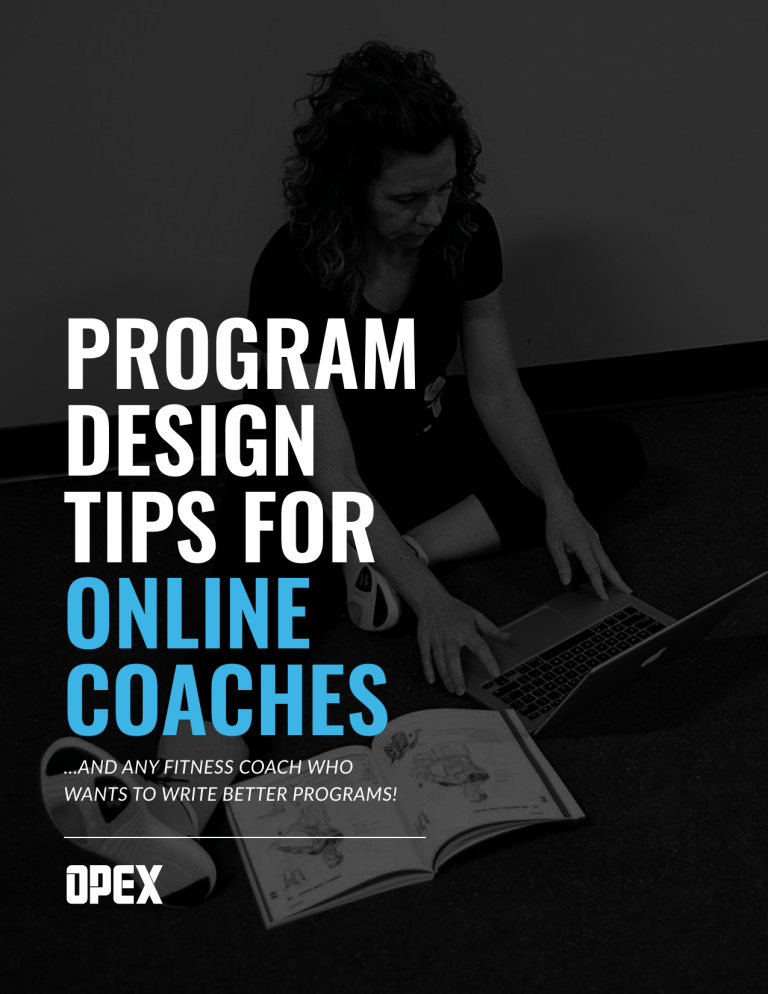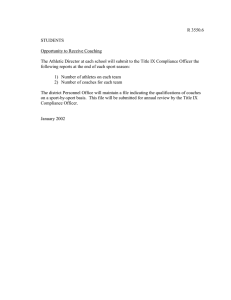
PROGRAM DESIGN TIPS FOR ONLINE COACHES ...AND ANY FITNESS COACH WHO WANTS TO WRITE BETTER PROGRAMS! To grow a remote coaching business, you have to simultaneously acquire new clients, while continuing to deliver an exceptional service to your existing ones. Striking this balance is a challenge, but it’s essential to achieve for your coaching career to thrive. If you don’t have program design principles in place from day one, you’ll waste time reinventing the wheel with every program you write and under-delivering to your clients. A subpar service means a low retention rate, forcing you to work even hard to acquire more new clients, and leaving you no time to do what you love the most—coaching. Adopting the systems and program design principles in this guide will ensure you offer your clients the premium programs they deserve—and get them the results to match. Incorporate these seven steps into your program design flow and you’ll be able to design individualized programs more efficiently and grow your coaching business to its full potential. Before you work through these seven steps, we recommend starting a free trial of the CoachRx program design & coaching software. We built CoachRx to integrate with these systems of coaching, giving you a professional tool you can use to coach your clients from anywhere. START YOUR FREE TRIAL 2 PROGRAM DESIGN TIPS FOR ONLINE COACHES SEVEN STEPS TO PROGRAM DESIGN EFFICIENCY STEP 1: USE A CLIENT INTAKE FORM The first step to program design success is to send and review an intake form for every client you onboard. What is it? The client intake is the first chance you will have to gather information about your client. It should be sent to the client before the assessment and consultation takes place. This form will give you insight into how much experience the client has with exercise and their current behaviors. By sending the intake prior to your first consultation, you will be better prepared to guide the conversation and can identify behavioral red flags to ask further questions on. Taking this initial step will enhance the professionalism of your coaching service and provide an important starting point for personalized program design. Using CoachRx? This intake form will be automatically sent to your clients when you add them. From the Intake form you should gather: • A brief fitness background and reason for hiring a coach. • Basic information about their current exercise, nutrition, and lifestyle behaviors. • Any prior health or medical conditions. Client Intake Form ABOUT YOU Age: Name: Why do you want a fitness coach? EXERCISE CLICK HERE TO DOWNLOAD A SAMPLE INTAKE FORM THAT YOU CAN USE WITH YOUR CLIENTS. How long have you consistently exercised? No consistent exercise 1-2 years 3-5 years 5+ years If you currently exercise, how many days per week? 1-2 3-4 5+ BEHAVIOR How many uninterrupted hours of sleep do you get per night? Under 5 5-6 What time do you wake up? 7-8 8+ What time do you go to sleep? Are you currently or have you ever followed a nutrition program? If so, what worked, what did not and why? How much water, in ounces, do you drink per day? *Please log 3 days of food, fluids and supplements in MyFitnessPal and send those to your coach prior to your initial consultation. 3 PROGRAM DESIGN TIPS FOR ONLINE COACHES STEP 2: THE INITIAL CONSULTATION During the intake process you should schedule an initial consultation with your new client. This will give you further background information on the client, their training history, help you set goals for the future, and begin to establish a solid foundation for your coach-client relationship. What is it? The consultation is an opportunity for you to get to know your client better and figure out their values and beliefs over a 60-minute 1:1 conversation. The initial consultation should not be overlooked as this is a chance to make a good first impression, start your coach/client relationship off right, and create alignment with the training program. For online clients, we recommend using Zoom or other video conferencing platforms. Pro Tip: You can add a link for you client to schedule ongoing monthly consultations in CoachRx account, visible from the client app. There are three critical things you should focus on during the consultation: 1. Gathering background information. This includes reviewing the client intake form and asking questions on exercise history and priorities, along with experience in exercise, nutrition, and lifestyle. 2. Understanding current behaviors, exercise, and nutrition. It is important to understand where a client is today to build a plan in each specific area. Have the client walk you through an average day and ask questions about their adherence to the Basic Lifestyle Guidelines. 3. Setting Goals. Work with the client to understand their reasons for hiring a coach and help them set clear and attainable goals. This will help guide the initial program design and ensure you and your client are aligned. Pro Tip: Keeping detailed notes on the initial consultation is a must. Relying on memory alone is a recipe for forgetting important client information and breaking their trust. This will only get more challenging as you grow your client roster. You can keep initial and monthly consultation notes for each client in CoachRx. 4 PROGRAM DESIGN TIPS FOR ONLINE COACHES STEP 3: CONDUCT AN ASSESSMENT Before you begin to prescribe an exercise program, it is essential to conduct a thorough assessment. This will give you information about the client and a starting point for their program. At OPEX, we use the three-part OPEX Assessment. What is it? The OPEX Body, Move, and Work Assessment is a systematic approach to gathering information directly from the client. This comprehensive client assessment evaluates body composition, movement limitations, and work capacity. The OPEX Body assessment is an analysis of the client’s height, weight, lean body, fat mass, basal metabolic rate, and other health biomarkers. The OPEX Move assessment involves taking the client through a variety of movements. The goal of this assessment is to establish what the client can and cannot do in terms of movement. The OPEX Work assessment is an initial test of the client’s work capacity. It is important to test work capacity as it gives you insight into what the client is capable of and what you should prioritize in their training program. FOR A DEEPER DIVE INTO THE CLIENT ASSESSMENT, DOWNLOAD THIS FREE GUIDE: FITNESS ASSESSMENTS FOR NEW CLIENTS. When you are finished you will have a full picture of client data to help you design a personalized fitness program. 5 PROGRAM DESIGN TIPS FOR ONLINE COACHES You should take away the following from the assessment: 1. Client capabilities 2. Training plan priorities (see step 4) 3. Guidance on exercise selection Pro Tip: Conducting an assessment is only beneficial if you track the data collected. Keep record of your client’s OPEX Body, Move, and Work scores inside of CoachRx to help you monitor their progress from day one. The process of assessment doesn’t end after the initial intake. You should continue to assess the client’s progress over time using Fitness Monitoring Exercises (FME). These tests look at data such as structural balance and energy systems, giving you insight into the client’s shifting priorities and progress. A few FMEs we like to test over time: • 20RM Goblet Squat for squat strength endurance • Max Duration Sorenson Hold for bend postural endurance • 8RM External Rotation and Powell Raise (compared to the Close Grip Bench Press 1RM for pull vs push structural balance) • 5k Row Time Trial for aerobic capacity In the OPEX Coaching Certificate Program you’ll learn our complete system of Fitness Monitoring Exercises, so you can track progress in all movement patterns and energy systems over time. Learn more about CCP here. Pro Tip: As well as leveraging our system of ongoing assessments and automated structural balance insights, you can add your own tests in CoachRx to ensure you’re capturing the most important data for your client’s training goals. 6 PROGRAM DESIGN TIPS FOR ONLINE COACHES STEP 4: DEFINE PRIORITIES Now that you have a clear understanding of the client’s starting point, it is time to define priorities. The priorities will guide your program design and ensure that it reflects their capabilities and goals. What is it? Defining priorities is the first step in transitioning from assessing to designing a program. This begins with analyzing the assessment and deciding what is most important to focus on first within the program. For example, in the consultation, you may have identified that improving sleep quality and protein intake are nutrition and behavior priorities. From the OPEX Move assessment, improving anterior core strength and scapular stability may be a priority, while the OPEX Body assessment may have revealed that decreasing body fat is a priority. Finally, the OPEX Work assessment may have highlighted that developing the aerobic energy system is a priority. All of these priorities must be recorded in a way that you can reference easily every time you sit down to program for your clients. One of the biggest mistakes we see coaches make is losing track of priorities over time. Priorities will make sure you always select progressions that are appropriate for each client, relative to their goals and function, and keep them progressing towards their goals. Pro Tip: You can tag priorities inside your client’s CoachRx account to ensure you never forget what each client is working on and help you manage your program design flow. Your defined priorities should include: 1. Exercise priorities, based on experience and capabilities 2. Lifestyle priorities 3. Nutrition priorities 7 PROGRAM DESIGN TIPS FOR ONLINE COACHES STEP 5: CREATE A PLAN Step five is creating a plan to help your client work on their priorities and reach their goals. What is it? Planning is the act of creating a road map for the client. In this phase, you and the client must decide exactly what it will take for them to reach their goals. Planning can include but is not limited to the days needed to train, the nutrition needed to support their goal, what equipment they will need, and lifestyle components. Planning is conducted considering the following: • The client’s goals • The assessment • The client’s training schedule • The priorities within the design • Your ability as a coach When you have finished planning you should have: 1. How many days a week they will train 2. Where they will train 3. The equipment and resources they have access to 4. How you will help the client reach their goals It sounds simple, but this planning phase is often overlooked when coaches rush to program design. To be personalized and effective, programs must be grounded in this reality. 8 PROGRAM DESIGN TIPS FOR ONLINE COACHES STEP 6: PERIODIZE THE PROGRAM The sixth step to enhance your efficiency is periodization. This is when you put pen to paper (or fingers to keyboard) and lay out a long-term training plan. Whether you have five clients or 50, failing to periodize will lead to procrastination and wasted time. Periodization is an essential step to keep your program designs on track from week to week, month to month, and cycle to cycle. What is it? Periodization is the act of building out training blocks that fit within the long-term training plan. When you periodize, you plan in blocks of time relative to the client’s goals, abilities, and training schedule. By thinking ahead and having a long-term plan in place, you’ll remove the guesswork from your program design and will always have a clear understanding of the characteristics and focus of each training cycle. Phases of training include: • Accumulation - The main focus of this phase is building volume, skills, and technical ability. • Intensification - Decreasing the volume of training and increasing intensity. • Pre-Competition - Simulating the structure of competition. • Competition - The act of competing. • Deload - Time taken off post-competition specifically for recovery. The person’s goals, function, training age, and assessment dictate how much, if any, of the above phases are appropriate. When you finish periodizing you should have: 1. The focus for each phase of training 2. How long each phase of training will last 3. Benchmarks for determining if it was successful, including scheduled FMEs Pro Tip: Utilize the Planning & Periodization feature in CoachRx to build long-term plans, plan training phases, and build a weekly split. 9 PROGRAM DESIGN TIPS FOR ONLINE COACHES STEP 7: STICK TO PROVEN PRINCIPLES Now, a deep dive into program design principles is outside of the scope of this free guide. (We have 100+ videos inside the Coaching Certificate Program curriculum specifically dedicated to program design.) LEARN THE COMPLETE SYSTEM OF OPEX PRINCIPLES SPANNING RESISTANCE TRAINING TO SKILL PROGRESSION TO ENERGY SYSTEMS IN CCP. However, here are our top 3 tips for program design strategy that are especially important for online coaches: 1. It is best practice to design 7 days at a time and on the same day per week for each client, for your productivity and for consistency. This allows you to review the previous week’s design and give feedback in a timely manner, adjust any progressions that did not go according to plan, and create consistency in your coaching practice. 2. Take the time to write a training split for each client at the beginning of every new cycle, so that you have a skeleton guiding you and you aren’t guessing when it comes to writing their weekly program design. For example: Monday - Squat, Pull (h), bend, push (v), lunge, core Tuesday - MAP 8 (cyclical) Wednesday - Bend, Push (h), lunge, pull (v), squat, core Thursday - Active Recovery Friday - Lunge, Pull (v), squat, push, bend, core Saturday - MAP 8 (cyclical) Sunday - Rest 3. It is essential to be clear and detailed in your workout descriptions so that your client understands the intent and exactly how to execute every exercise, especially when you’re not in-person during their workout. For example, if your client is starting with back squats, write the exercise as follows: Back Squat (with example video linked) @30X0 6-8 reps x 4 sets Rest 2 minutes • Focus on sitting hips back and big toes pressed into ground • Please film last set from side 10 PROGRAM DESIGN TIPS FOR ONLINE COACHES UNDERRATED ONLINE COACH TIP: CONSISTENT ONLINE COMMUNICATION Being a great remote coach who retains their clients isn’t just about reps and sets—any template can offer that. The most important and underrated factor for online coaching success is consistency in communication. Regular communication around your client’s training is essential to develop the relationship and provide them with value. When you onboard each client be sure to set an expectation of how much they should expect to hear from you and how they need to communicate with you. For example, let them know upfront that you will respond to their messages within 3 hours during working hours and that the best place to ask you questions is in CoachRx messages. Leaving a comment on each training session, answering any questions or concerns raised in the client results, and commenting on your client’s workout videos will help create consistent communication. Consider using a video messaging service like Loom (available as an integration in CoachRx) to provide video feedback on your client’s training sessions. 11 PROGRAM DESIGN TIPS FOR ONLINE COACHES PROGRAM DESIGN FOR ANY CLIENT, ANYWHERE The best programs begin well before you sit down to write your client’s workout for the day. Throughout the steps contained in this guide, we hope you’ve realized that great programs rely on a foundation of assessment, consultation, planning, periodization, and effective communication. In short, to constantly deliver premium program designs to all of your clients, you need coaching systems. The OPEX Coaching Certificate Program (CCP) provides just that. Taught by industry leaders, CCP is the most comprehensive online coaching education and mentorship program. This course teaches you the OPEX method, a proven system for designing long-term training programs for any client, anywhere. You’ll stop wasting your time, underdelivering, and churning clients, and start programming with confidence. On top of learning a scalable system of coaching and participating in our live mentorship experience, all OPEX coaches get hands-on experience implementing program design principles with our premium coaching software, CoachRx. Enrollment is now open for our upcoming mentorship group. Limited spots are available each quarter, so secure yours today. APPLY NOW TO GET STARTED



